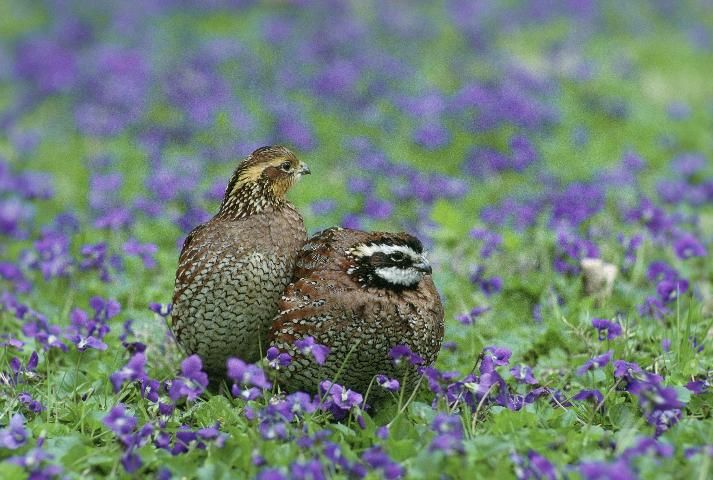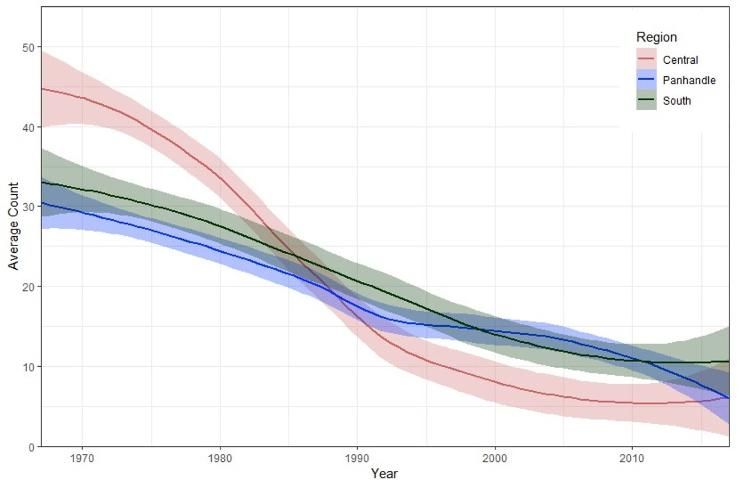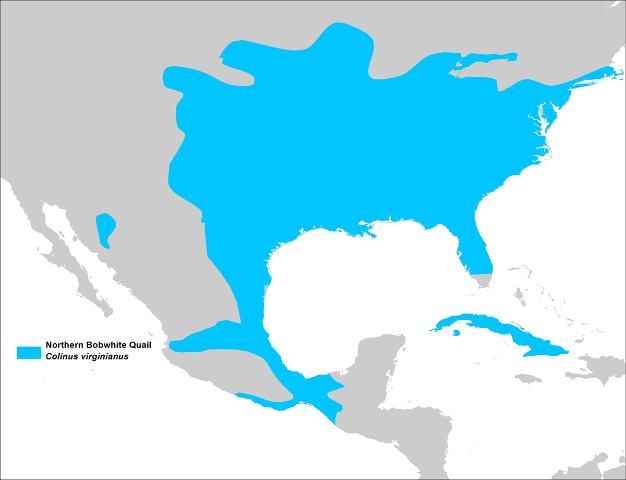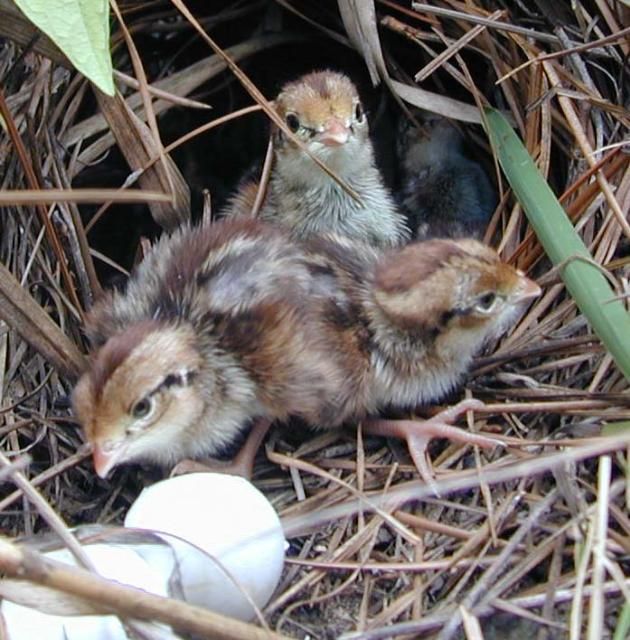
Credit: Steve Maslowski, USFWS
Florida's Fire Bird
-
Breeding = spring, summer
-
Habitat = grassland, flatwoods, scrub
-
Status = none
Scientific Name: Colinus virginianus
Common names: northern bobwhite, bobwhite, quail
Habitat: Frequently burned, mature, open, upland pine forests, agricultural fields, dry prairies, scrub, and grasslands.
Physical Description: Medium-sized, round-bodied birds with short necks and tails. Brown, gray, and reddish feathers on their backs, cream to white feathers on their bellies with grayish feathers in the wings. Males have a black-and-white stripe on their heads, with a white throat patch. Females have a tan and buff brown stripe and throat patch. Average body length of 10 inches and wing span of 9–11 inches.
Weight: 5–7 ounces
Reproductive Rate: 23-day average incubation; 11–15 eggs; hatching starts as early as late April but peaks late May to early July.
Lifespan: Can live up to 6 years, but annual survival of adults is only about 20%.
Dispersal & Home Range: Parents care for the chicks for at least a month after hatching, then, in a process known as the "fall shuffle," family groups break up and assemble into coveys. Average home range size is 139 acres.
Visit https://bringbackbobwhites.org/ to listen to a Male Spring Call and a Fall Covey Call
History
Northern bobwhite quail were historically abundant in Florida. Following European settlement, fire was suppressed, habitat fragmented, and quail populations began to decline. In addition, conversion from traditional agricultural practices to clean farming practices removed early successional habitats such as fallow fields and hedgerows that bobwhite needed. Over the past three decades, it is estimated that bobwhite quail have declined over 70%.

Credit: Data Citation: Pardieck, K. L., D. J. Ziolkowski Jr., M. Lutmerding, and M. A. R. Hudson. 2018. North American Breeding Bird Survey Dataset 1966–2017, version 2017.0. U.S. Geological Survey, Patuxent Wildlife Research Center. https://doi.org/10.5066/F76972V8.
Did you know?
The northern bobwhite is known as the "fire bird" because they evolved to live in habitat maintained by frequent, low-intensity fire.
Fast Facts
-
Less than 20% live to be a year old.
-
Form groups called coveys that can be counted to assess population densities.
-
Covey calls are a quail's way of saying an area is occupied.
-
Unlike most birds, quail roost on the ground.
Distribution
Northern bobwhite are native to the southeastern United States, eastern Mexico and the Caribbean. They are found throughout most of Florida except for the lower Keys. There are 22 subspecies of northern bobwhite, with two found in Florida (eastern subspecies in north Florida C.v. virginianus and Florida subspecies found in south Florida, C.v. floridanus).

Credit: BirdLife International and Handbook of the Birds of the World (2017) Bird species distribution maps of the world. Version 7.0. Available at http://datazone.birdlife.org/species/requestdis
Biology and Behavior
Northern bobwhite quail live and feed on the ground. In Florida they live in a variety of habitats such as flatwoods, prairies, scrub, and upland pine. They require a mosaic (often referred to as a crazy-quilt) of different vegetation structure to nest, roost, forage and escape predation. Northern bobwhite are adapted to frequent, low-intensity fires, which historically occurred every 2–5 years in Florida. Today, land managers use prescribed fire to mimic those natural disturbances and create the "crazy-quilt" mosaic quail need. Adult northern bobwhite primarily forage on seeds, but before they lay eggs, adults consume more insects. A tight social covey of 11–12 birds helps quail avoid predators, forage, and stay warm. In early spring, coveys break up as the birds search for mates. Males and females will often have multiple mates during a season. Nests are constructed from dead grasses and forbs in fields dominated by herbaceous vegetation. On average, 32–44% of nests successfully hatch. Failures are often a result of predation or weather. Common predators include fire ants, cooper's hawks, snakes, bobcats, and other mammals. Due to low nest success, northern bobwhite often re-nest 2–3 times during a season.

Credit: Steve Maslowski, USFWS
Managing the Habitat—"Build it and they will come"
The best way to improve habitat is to maintain fire on the landscape using a rotational burn system, with different time-since-fire areas adjacent to each other. Large properties should attempt to maintain growing-season prescribed burns. Smaller properties should create patches of foraging, nesting, and escape habitat that are connected or in close proximity. In pine savannas, burn small patches (40–100 acres) every 2 to 3 years in April, May, and early June. Mechanical treatments such as rotational strip disking on a one-, two-, and three-year rotation, like fire rotation, can also allow for a mixture of plant communities. Keep tree basal area low (average area occupied by tree trunks and stems) to 30–40 ft²/ac. Herbicides such as Imazapyr and Triclopyr are also an option to reduce woody vegetation but fire or mechanical systems are preferred. Leave small patches of woody vegetation for escape from predators. A cattle grazing system can help maintain grasses and forbs, but avoid overgrazing, which could reduce food sources. Sufficient habitat in Florida can support up to 1 bird per acre, but densities are usually 1 bird per 3 acres.
How You Can Help
-
Create a "crazy-quilt" using prescribed fire and mechanical treatment.
-
Talk with local agencies and private land consultants about how to manage your land for quail.
-
Record your sightings at the Florida Wildlife Sightings website https://app.myfwc.com/HSC/Quail/.
More information and factsheets at https://edis.ifas.ufl.edu:
National Bobwhite Conservation Initiative
Florida Fish and Wildlife Quail Information and Hunting Resources